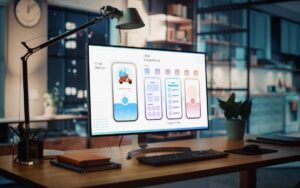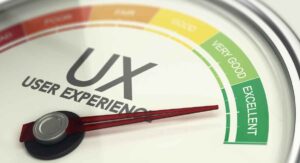UI and UX are two fundamental aspects of creating a digital product and play a major role in its success. UI stands for user interface, and UX stands for user experience. Both are vital in a digital product development environment.
If you want to pursue a UI and UX design career, you might wonder how to prepare for the interview process. In this article, we will cover some of the standard UX/UI interview questions you might encounter and some tips on how to answer them effectively. We will also provide a step-by-step guide on preparing for a UX/UI interview and a link to online UX/UI design training to help you master the skills and tools needed for this field.
What is UI and UX Design?
UI and UX design are crucial to creating user-friendly and engaging digital products. Here is a quick look at what they are:
User Interface (UI)
UI design focuses on the aesthetics and functionality of a product. This includes colors, fonts, icons, buttons, menus, etc. UI designers aim to create attractive, intuitive, consistent, and responsive interfaces. The process involves many steps, like creating prototypes and mockups demonstrating how the product will look and behave.
User Experience (UX)
UX design focuses on the usability and accessibility of a product, such as the navigation, interaction, feedback, etc. UX designers aim to create experiences that are user-centered, empathetic, meaningful, and enjoyable. UX design also involves conducting user research and testing that validate how the product meets the needs and expectations of the users.
The UX market had a valuation of USD 6,120.64 million in 2020, with a projected growth of USD 20,058 million by 2028. A good UI and UX can have a direct impact on the business. In this area, for every dollar allocated to user experience (UX), there is a $100 return on investment, according to Forrester. In fact, after experiencing poor user interface, 88 percent of users are unlikely to come back.
Also Read: Accessibility in UX Design: A Definitive Guide
Common UX/UI Interview Questions
Let’s begin with the basics when considering the common UX/UI designer interview questions. This section is ideal if you are a beginner. But some interviewers may want to know your understanding of the basics and hence may ask you from these.
#1. Tell me about yourself
This is a common yet perplexing question for applicants, even for UX/UI designers. When answering, stick to summarize your resume, focusing on relevant work experience, education, internships, and previous UX/UI roles. Mention your current job and why you’re interested in the position, showcasing your qualifications for the role.
#2. Why UX design?
In interviews, especially for entry-level roles, this is a common question. Emphasize your aptitude in user empathy, problem-solving, time management, and curiosity about industry trends.
#3. Define UX design.
Avoid generic definitions; interviewers seek your interpretation. Use real-life examples like Airbnb’s success attributed to UX design or Jeff Bezos prioritizing customer experience over advertising at Amazon’s inception. Emphasize UX design’s role in enhancing the usability and user-friendliness of websites, apps, and products.
#4. Explain the difference between UX and UI design.
Distinguish between these often interchanged terms. Highlight that UX focuses on effective product functionality, while UI is concerned with aesthetics. Mention collaborative experiences with UI teams in previous roles to show your understanding of both roles and their importance.
#5. What is meant by design thinking?
Design thinking is an approach to design that involves empathizing with the problem, defining it, ideating solutions, prototyping, and testing. It begins with understanding the problem by consulting experts and observing user experiences. Then, analyzing and defining the problem, ideating solutions with user needs in mind, and creating prototypes. Finally, testing the product to ensure it meets user requirements. It’s a user-centric and iterative process.
#6. Why do you want to work for us?
Tailor your response to the company’s values and mission. In a tech startup, highlight your enthusiasm for innovation and a fast-paced environment. For a big corporation, focus on your appreciation for the stability offered by an established team of UX designers.
Also Read: Top 9 Memorable UX Design Examples
#7. What’s your primary focus among UX Researcher, UX Designer, or Visual Designer?
This is where you are asked to show your true self. Instead of claiming expertise in all areas, focus on your greatest strength. This approach demonstrates research into the company’s needs and makes your expertise shine during the interview.
#8. What are the critical skills of a UX designer?
Essential skills include prototyping, wireframing, and mockups, adapting to various stages of product development. They should also be proficient in visual design tools and understand typography, color theory, and icons. Effective collaboration with cross-functional teams and strong communication and presentation skills are vital for gathering customer insights and conveying ideas to stakeholders.
#9. Can I see your portfolio?
When asked for your portfolio, it’s not just about showcasing skills listed in your resume and cover letter. Discuss each project instead of silently presenting your UX/UI design portfolio. Explain your design methodology and provide insights into your decision-making process. For added impact, create a UX design case study for each project, including prototype photos and wireframe screenshots in Figma or Adobe XD for clarity.
#10. What design process did you use for these projects?
The interviewer wants to know more about your thought process and design decisions. While discussing your portfolio, detail the problems you aimed to solve and your approach to solving them. Answering confidently showcases your expertise.
#11. Can I see your favorite project?
This can be a tricky question. Be cautious when answering. Choose a project aligned with the company’s design style rather than the most aesthetically pleasing. Describe the project in detail, showcasing your ability to tackle challenging design tasks, especially if the interviewer lacks a design background.
#12. What makes a good UX designer?
This question will give the interviewer insights into your goals as a UX/UI designer. A strong UX designer possesses empathy to grasp user needs and seeks innovative solutions. They embrace feedback, continuously striving to enhance the product and their skills. They should be receptive to improvement and adaptable.
#13. Share a time when a project went wrong and how you resolved it.
This is a very common interview question. Craft an answer highlighting your composure and logical problem-solving. Carefully select an example, avoiding self-inflicted errors like missed deadlines or design mistakes. Focus on challenges stemming from external factors to demonstrate your skills.
#14. Name websites and apps with great design.
This question gauges your assessment of UX/UI work. Focus on aspects beyond aesthetics, discussing user interface and experience elements. For instance, highlight effective information architecture aiding user task completion. Showcase understanding of UX design’s impact on digital product success.
#15. What are some common mistakes in UX design?
Neglecting business needs is a common mistake. UX designers sometimes prioritize differently from stakeholders. Collaboration is key here. Proposed changes can be costly. However, pushing for radical changes can backfire and harm our efforts. Frame the answer to highlight your skills in working in a team.
#16. How do you approach user research, and which methods do you use?
Frame the answer to show that you decide on research methods based on project goals. Say that you assess various options for their potential value. Mention common methods like user interviews, surveys, usability testing, diary studies, contextual inquiry, and data analysis. The choice depends on the specific project and its objectives.
#17. How would you go about conducting a UX evaluation?
You should begin by clearly defining your evaluation goals and method selection. Focus on usability testing and user behavior analysis. These approaches yield valuable data for identifying actionable insights to enhance the user experience.
Also Read: The UX/UI Design Process: Everything You Need to Know
Behavioral UX/UI Designer Interview Questions
Behavioral interview questions are a common part of UI/UX interviews. They are focused on your past experiences and how you handle situations. Let us look at some common behavioral UX/UI designer interview questions.
#1. Can you walk me through your design process?
This question explores your approach to UX design. Walk them through your problem-solving methods, research techniques, and stakeholder collaboration. Focus on your user-centric approach and teamwork skills.
#2. Can you describe a time when you had to change your design approach?
UX design often requires flexibility. Narrate an instance when you adjusted your approach due to new information or feedback. Explain the situation, reasons for the pivot, and the outcome of your revised strategy.
#3. Can you describe a time when you had to convince stakeholders to follow your design direction?
UX designers often need to gain buy-in from stakeholders. Show your communication skills and ability to influence others. Describe the scenario, your design rationale, and the result of your efforts.
#4. Describe a time when you had to work with a difficult team member.
Collaboration is key in UX design. Share an experience working with a challenging team member. This is an opportunity to highlight your conflict resolution abilities. Provide context, explain the conflict, and detail how you resolved it.
#5. How do you use negative feedback to improve your design?
Feedback plays a vital role in UX design. Discuss how you handled negative feedback from stakeholders, users, or team members. Outline the situation, the feedback received, and how you used it to enhance your design.
Also Read: UX Metrics: What Matters When Measuring User Experience
Questions About Workflow and Process
In UI/UX interviews, questions about your workflow and process help the board understand how you approach projects, collaborate with teams, and solve design challenges. Let’s look at some common questions you can expect.
#1. What is the most challenging project you’ve worked on?
Highlight your ability to tackle challenges effectively. Select a specific challenge from a complex project, briefly explaining it and your solution. For example, discuss the redesign of a large-scale e-commerce platform and how you adapted to its scale and complexity.
#2. How do you decide which features to add to your product?
Share your user-centric approach. Start with thorough user research to understand their needs. Brainstorm feature ideas based on user insights. Then, consider the feasibility from a business perspective. Strive for a balanced solution that meets user needs and aligns with business goals.
#3. How do you measure the success of a design project?
Demonstrate your approach to measuring success. Mention a range of metrics and methods, such as task completion rates, error rates, time on task, click-through rates, and user engagement metrics. Show that you consider usability and user engagement when assessing success.
#4. Describe your experience With A/B Testing.
Highlight your expertise in A/B testing, a vital UX tool. Explain your process, including setting objectives, forming hypotheses, and selecting variables like layout, color schemes, and CTAs. Showcase how A/B testing helps optimize and refine designs.
Also Read: What is UX Writing? Why It Matters, Tools, and Career Skills
How to Prepare for UX/UI Interview
Preparing for a UX/UI interview can be a challenging process. But with careful planning and practice, you can greatly improve your chances of success. Here’s a step-by-step guide to help you get ready for your UX/UI interview:
Step 1: Research the Company and Product:
Start by thoroughly researching the company you’re interviewing with. Explore their website and learn about their mission, vision, values, and company culture. Gain a deep understanding of the product or projects you’ll be working on. Familiarize yourself with its features, functions, target users, and competitors.
Highlight any alignment between your values and the company’s mission to demonstrate your genuine interest in the role.
Step 2: Review Your Portfolio and Projects:
Look closely at your portfolio and the projects you’ve worked on. Be ready to discuss them in detail during the interview. Prepare to explain your design decisions, the challenges you faced, and the outcomes you achieved.
Select specific examples or stories from your portfolio that showcase your UX/UI design skills and problem-solving abilities.
Step 3: Practice Your Answers and Questions:
Practice answering common UX/UI interview questions to articulate your thoughts clearly and confidently. Consider using the interview questions mentioned earlier as a reference. Conduct mock interviews with a friend or mentor, or use online platforms to receive valuable feedback on your performance.
Also, prepare thoughtful questions to ask the interviewer about the company, product, team, or role. This demonstrates your genuine interest and engagement.
Step 4: Dress Appropriately and Be Punctual:
On the interview day, dress professionally and per the company culture. Make sure that you arrive on time for the interview. Being punctual reflects your reliability and respect for the interviewer’s time.
Gather essential materials, such as printed copies of your resume and portfolio, and check your interview setup, including your internet connection and devices.
Step 5: Exude Confidence and Enthusiasm:
During the interview, maintain a confident and enthusiastic demeanor. Answer questions clearly and concisely, providing relevant examples from your experience.
Express your genuine passion for UX/UI design and excitement about the potential role. Listen to the interviewer’s questions and comments and engage in meaningful dialogue.
By following these steps and thoroughly preparing for your UX/UI interview, you can present yourself as the ideal candidate for the role. Don’t forget to stay updated on the latest UX/UI trends and consider enrolling in an online UX/UI program to enhance your skills further.
Tips to Ace UI and UX Interview
Now that you know how to perform in an interview, here are some tips from our experts to shine in the interview.
- Practice with Designers and Non-Designers: Prepare to explain your work in a way understandable to both design experts and non-designers.
- Screen Sharing Readiness: Be prepared to share your UX design portfolio on-screen during the interview. Keep it organized and ready to showcase your projects.
- Thoughtful Responses: Take your time when answering questions, especially design challenges. Think aloud to demonstrate your analytical problem-solving skills.
These tips will help you communicate your skills and experience effectively during your UI and UX interview.
Also Read: How to Write a UX Designer Resume?
Get Started With Your UX/UI Journey
We hope after reading this guide, you’ll have gained insights into the types of UX/UI interview questions you may face and how to approach them effectively. Prepare thoroughly, showcase your skills and experiences, and demonstrate your passion for creating exceptional digital experiences. This way, you can confidently navigate the interview process and increase your chances of success.
To enhance your chances of success, consider building a solid academic foundation without UX/UI bootcamp. This prestigious program offers many opportunities for aspiring and current designers. Its curriculum covers top design tools, hands-on learning, and networking with industry experts. This bootcamp is an excellent opportunity for you to upskill and grow in UX/UI design.
Remember, every interview is an opportunity to showcase your expertise and make a lasting impression on potential employers. Good luck with your UX/UI interviews!
You might also like to read:
A Look at 10 Great UX Portfolio Examples
Understanding Usability Testing Methods For Effective UI/UX Design
The Ultimate Guide to Mobile UI/UX Design: Elevating User Experience in the Digital Age
What is UI/UX Testing? Exploring This Critical Function of Digital Design






